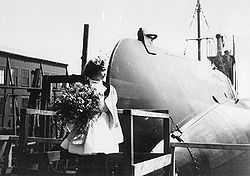USS C-2 (SS-13)
.jpg) USS C-2 in the Atlantic Ocean sometime between 1912 and 1919. | |
| Career | |
|---|---|
| Name: | USS Stingray |
| Builder: | Fore River Shipyard, Quincy, Massachusetts |
| Laid down: | 4 March 1908 |
| Launched: | 8 April 1909 |
| Commissioned: | 23 November 1909 |
| Decommissioned: | 23 December 1919 |
| Renamed: | C-2, 17 November 1911 |
| Struck: | 23 December 1919 |
| Fate: | Sold for scrap, 13 April 1920 |
| General characteristics | |
| Class and type: | C-class submarine |
| Displacement: | 238 long tons (242 t) surfaced 275 long tons (279 t) submerged[1] |
| Length: | 105 ft 4 in (32.11 m) |
| Beam: | 13 ft 11 in (4.24 m) |
| Draft: | 10 ft (3.0 m) |
| Propulsion: | Craig gasoline engines electric motors 2 × shafts |
| Speed: | 10 kn (12 mph; 19 km/h) surfaced 9 kn (10 mph; 17 km/h) submerged[1] |
| Complement: | 15 officers and enlisted |
| Armament: | 2 × 18 in (460 mm) bow torpedo tubes (4 torpedoes)[1] |
USS C-2 (SS-13) was a C-class submarine of the United States Navy.

C-2 was laid down by Fore River Shipbuilding Company in Quincy, Massachusetts — under a subcontract from Electric Boat Company — as USS Stingray. She was launched on 8 April 1909 sponsored by Ms. Elizabeth Stevens, and commissioned on 23 November 1909, Ensign E. B. Armstrong in command. She was renamed USS C-2 on 17 November 1911.
Service history
C-2 — assigned to the Atlantic Torpedo Fleet and later the Atlantic Submarine Flotilla — cruised along the East Coast until 20 May 1913, when she cleared Norfolk, Virginia for six months of operations from Guantánamo Bay, Cuba. In December, she reported at Cristóbal, Colón, Panama, and began an operating schedule of torpedo practice, exploration of anchorages, and harbor defense duty at ports of the Panama Canal Zone. During the latter part of World War I, C-2 patrolled the Florida coast. The submarine was placed in ordinary at Coco Solo, Canal Zone on 22 August 1919, and was decommissioned on 23 December 1919. She was sold for scrap on 13 April 1920.
References
- This article incorporates text from the public domain Dictionary of American Naval Fighting Ships. The entries can be found here and here.
External links
- Photo gallery of USS Stingray at NavSource Naval History